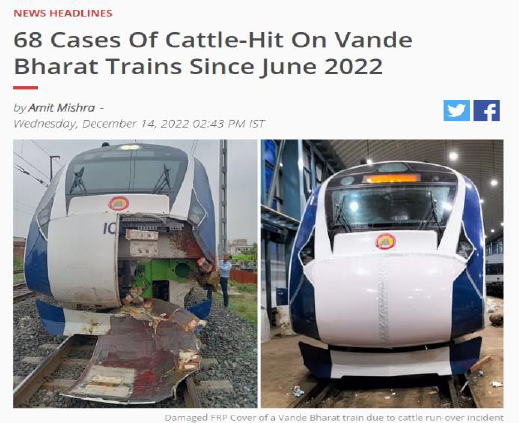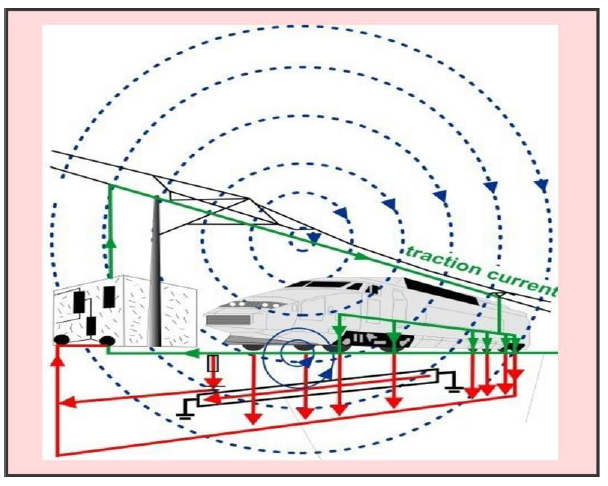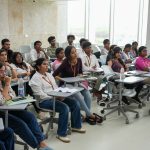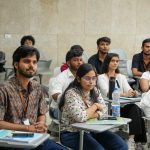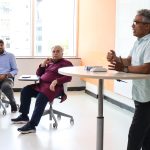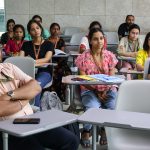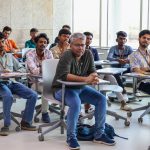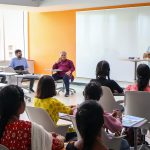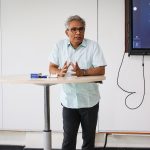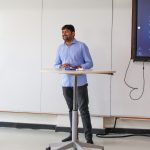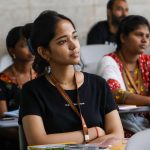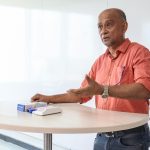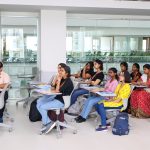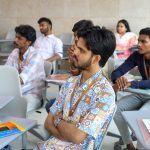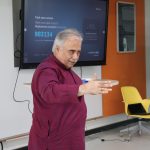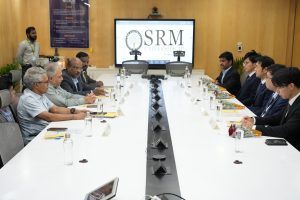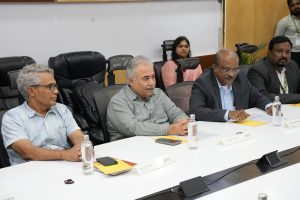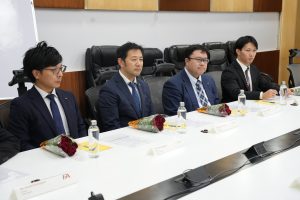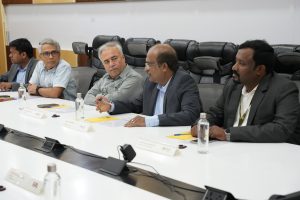Faculty and Students Leads to Patent Publication for Intelligent Shelf Management System
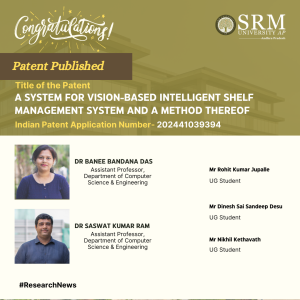 In a groundbreaking collaboration, Dr Banee Bandana Das, Assistant Professor in the Department of Computer Science and Engineering, and Dr Saswat Kumar Ram, Assistant Professor in the Department of Electronics and Communication Engineering, have joined forces with Btech-CSE students Mr Rohit Kumar Jupalle, Mr Dinesh Sai Sandeep Desu, and Mr Nikhil Kethavath to develop and patent an innovative invention.,” The team’s invention, titled “A SYSTEM FOR VISION-BASED INTELLIGENT SHELF MANAGEMENT SYSTEM AND A METHOD THEREOF,” has been officially filed and published with Application Number 202441039394 in the Patent Office Journal. This invention showcases the academic excellence and collaborative spirit within the institution, as faculty members and students work together to push the boundaries of technology and create solutions with real-world impact.
In a groundbreaking collaboration, Dr Banee Bandana Das, Assistant Professor in the Department of Computer Science and Engineering, and Dr Saswat Kumar Ram, Assistant Professor in the Department of Electronics and Communication Engineering, have joined forces with Btech-CSE students Mr Rohit Kumar Jupalle, Mr Dinesh Sai Sandeep Desu, and Mr Nikhil Kethavath to develop and patent an innovative invention.,” The team’s invention, titled “A SYSTEM FOR VISION-BASED INTELLIGENT SHELF MANAGEMENT SYSTEM AND A METHOD THEREOF,” has been officially filed and published with Application Number 202441039394 in the Patent Office Journal. This invention showcases the academic excellence and collaborative spirit within the institution, as faculty members and students work together to push the boundaries of technology and create solutions with real-world impact.
This significant achievement not only highlights the creativity and dedication of the individuals involved but also underscores the institution’s commitment to fostering a culture of innovation and research. The publication of this invention paves the way for further exploration and development in the field of intelligent shelf management systems, demonstrating the potential for transformative contributions to the industry.
Abstract
This research offers the best solution to improve the business in the retail realm, maintaining On- Shelf Availability (OSA) is vital for customer satisfaction and profitability. Traditional OSA methods face accuracy challenges, prompting a shift to deep learning models like YOLO and CNN. However, data quality remains a hurdle. This research introduces OSA, a novel semi-supervised approach merging ’semi-supervised learning’ and ’on-shelf availability’ with YOLO. It reduces human effort and computation time, focusing on efficient empty-shelf detection. Implementing a Vision-Based Intelligent Shelf Management System empowers retailers with real-time insights, revolutionizing decision-making. The model is optimized for diverse devices and provides practical solutions for efficient retail operations. Balancing model complexity, size, latency, and accuracy, the research paves the way for an advanced, data-driven shelf management approach, contributing to improved shopping experiences and business profitability
Practical Implementation and the Social Implications Associated
1. The present invention is a time-saving method in maintaining the stocks.
2. The use Vision-Based Intelligent Shelf-Management System provide a well alternative in reducing the labor efforts.
3. The system will help in terms of self-management system using machine learning techniques to optimize restocking decisions.
The present invention can be used in shopping malls and business areas for enhancing customer experiences and business and few application areas are:
• Smart City and smart Village
This technique and system can reduce the human efforts in identifying vacant slots for items in business areas and provides necessary inputs to fill the same within a time frame.
• Automobile Industry
The system can be easily integrated with the showrooms to identify the empty spaces and inform to get it fill with products.
Collaborations
SRM AP Faculties and UROP Students
Future research plan
In the future, different deep learning and machine learning methods can be merged to explore better performance in identifying overlapping objects.
- Published in CSE NEWS, Departmental News, ECE NEWS, News, Research News
Revolutionising Cattle Safety
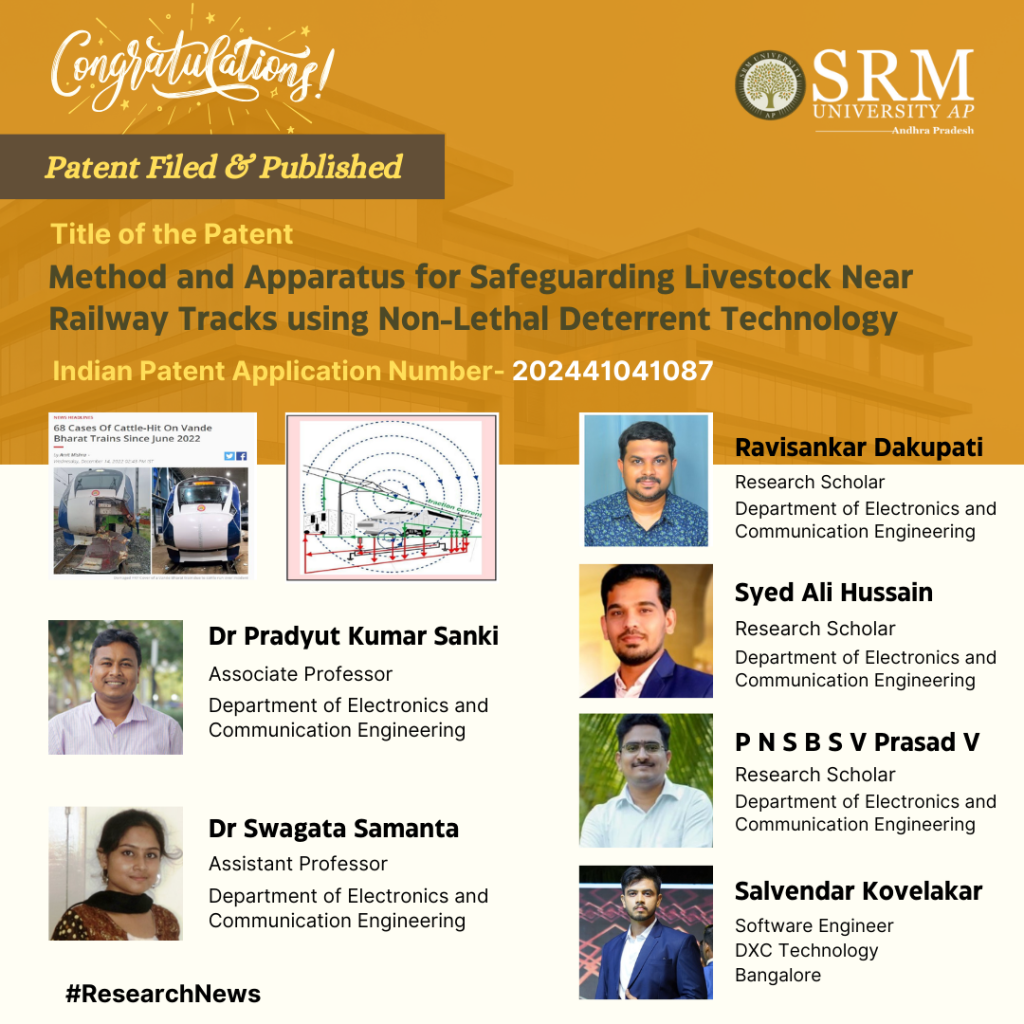
The Department of Electrical and Communication Engineering at SRM University-AP is delighted to announce the publication of a patent by its faculty, including Associate Professor Dr Pradyut Kumar Sanki and Assistant Professor Dr Swagata Samanta, along with research scholars Ravisankar Dakupati, Syed Ali Hussain, and P N S B S V Prasad V. The patent, titled “Method and Apparatus for Safeguarding Livestock Near Railway Tracks using Non-Lethal Deterrent Technology,” has introduced a groundbreaking solution that helps prevent accidents of wandering cattle. This innovative technology promises to protect livestock and minimise economic losses for cattle owners while championing the advancement of technology in countries like India.
Abstract:
Nowadays we have been hearing that Vandebharat express train hits cow, causing damage to both railways and cattle owners. We need to find a solution to this problem. These issues shouldn’t be hurdle for the growth of technology for developing countries like india. The technology we are going to use is a belt is worn by a cow. When the cow tries to cross near railway track it receives a Non-Lethal shock, makes the cow to scare and move back. All this circuit is operated with 7.4V DC
Practical implementation:
The practical implementation of the Anti-Track Cattle Band involves equipping cows with the device to prevent accidents near railway tracks. By detecting magnetic fields and delivering non-lethal shocks, the device ensures the safety of both the cattle and the railway infrastructure. This implementation can significantly reduce the risk of collisions and protect valuable livestock.
From a social perspective, the invention has several implications. It addresses the safety concerns of both animals and humans by preventing accidents and minimizing potential harm. By safeguarding livestock near railway tracks, the technology contributes to animal welfare and reduces economic losses for cattle owners. Additionally, the device promotes a more humane and proactive approach to mitigating risks associated with animal-human interactions in railway environments.
Collaborations:
The research on the Anti-Track Cattle Band involved collaboration among a team of inventors with diverse expertise:
Ravisankar Dakupati – Research Scholar at SRM University-AP
Salvendar Kovelakar – Software Engineer at DXC Technology, Bangalore
Syed Ali Hussain – Research Scholar at SRM University-AP
P N S B S V Prasad V – Research Scholar at SRM University-AP
Dr Pradyut Kumar Sanki – Associate Professor at SRM University-AP
Dr Swagata Samanta – Assistant Professor at SRM University-AP
This collaborative effort brought together individuals with backgrounds in research, software engineering, and academia to develop and implement the innovative Anti-Track Cattle Band technology.
Future Research Plans:
In future research for patent publication regarding “Apparatus and Method for Railway Livestock Protection,” the focus will likely be on enhancing sensor technology to detect animals more accurately over longer distances and in various conditions. This could involve integrating artificial intelligence and machine learning for improved detection and reducing false alarms. Additionally, there may be efforts to develop systems for remote monitoring and control, enabling real-time adjustments from a central location. Adaptability to different environments, collaboration for standardized protocols, cost-effectiveness, and assessing environmental impacts will also be key areas of interest. Overall, future research aims to create more effective, efficient, and sustainable solutions for protecting livestock around railway tracks
- Published in Departmental News, ECE NEWS, News, Research News
A Breakthrough Patent for the Automated Abnormality Detection System
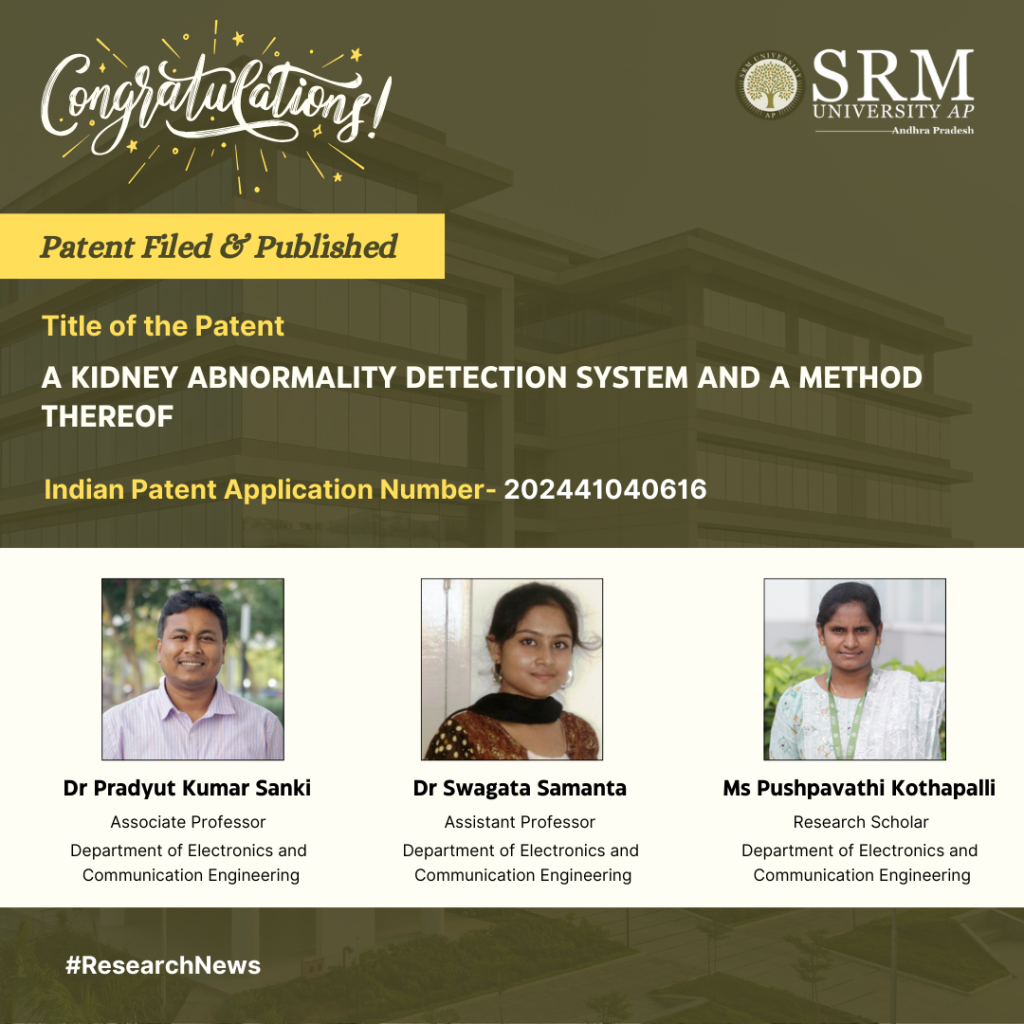
Dr Pradyut Kumar Sanki, Dr Swagata Samanta, and research scholar Ms Pushpavathi Kothapalli from the Department of Electronics and Communication Engineering published their patent titled “A Kidney Abnormality Detection System And a Method Thereof,” with Application No. 202441040616. This innovative method, which utilises advanced deep learning techniques, promises to revolutionise the accuracy and efficiency of kidney disease diagnosis. With the potential for widespread clinical adoption, this technology aims to enhance patient care, offering a brighter future for kidney disease detection and treatment.
Abstract:
This research work aimed to develop a method for detecting kidney diseases, including kidney stones, cysts, and tumors. The method achieved high accuracy in detecting kidney diseases, with a good mean average precision, precision, and recall. The study used techniques to select the most relevant features for kidney disease detection, identifying top features related to blood tests and patient health. The method outperformed other approaches in terms of accuracy, precision, and recall. The study used a comprehensive dataset of kidney disease patients to train and test the method. The results suggest that the method has the potential to be widely adopted in clinical settings, contributing to more accurate and efficient diagnostic tools for kidney disease detection and improving patient care.
Practical implementation:
The practical implementation of our research involves deploying a system for real-time detection and classification of kidney disease, including kidney stones, cysts, and tumors. The method achieved high accuracy in detecting kidney diseases using the Deep learning technique. Our model can quickly identify the disease of the kidney. The study used techniques to select the most relevant features for kidney disease detection, identifying top features related to blood tests and patient health. The method outperformed other approaches in terms of accuracy, precision, and recall. The study used a comprehensive dataset of kidney disease patients to train and test the method. The results suggest that the method has the potential to be widely adopted in clinical settings, contributing to more accurate and efficient diagnostic tools for kidney disease detection and improving patient care.
Future Research Plans:
The future plans for the work on chronic kidney disease (CKD) detection and management involve several key areas:
1. Improved Screening and Diagnosis: Update the United States Preventive Services Task Force (USPSTF) recommendation for CKD screening to reflect current evidence supporting routine screening for high-risk asymptomatic adults.
2. Enhanced Patient Engagement and Person-Centered Care: Advance education of primary care clinicians about CKD risk factors, testing, detection, and interventions that are graded and proportional to the eGFR and uACR risk stratification or heat map.
3. Advancements in Nephrology: Develop novel therapeutic strategies, such as wearable artificial kidneys, xenotransplantation, stem cell-derived therapies, and bioengineered and bio-artificial kidneys, to improve renal replacement therapies and address the shortage of kidney donors.
4. Machine Learning and Predictive Modelling: Continue to evaluate and improve machine learning approaches for early CKD diagnoses, focusing on reducing the number of input features and enhancing the accuracy of prediction models.
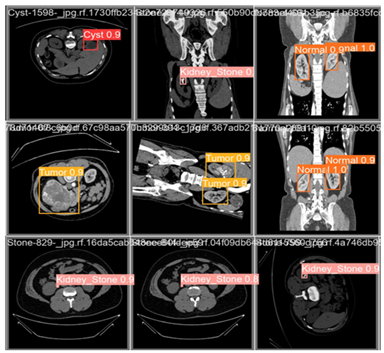
- Published in Departmental News, ECE NEWS, News, Research News
Dr Basu Pens a Book on Life’s Boulevard
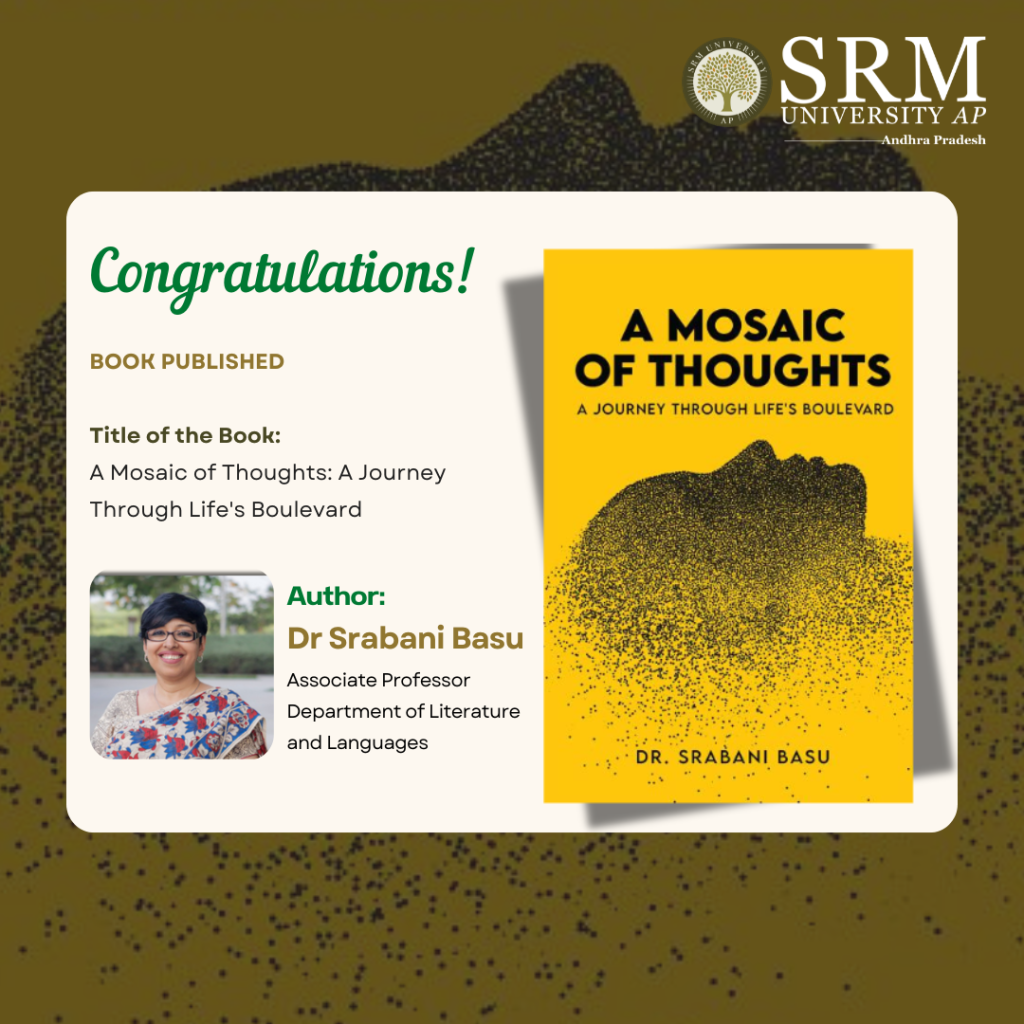 In the esteemed corridors of academia, where the pursuit of knowledge intertwines with the art of mentorship, Dr Srabani Basu emerges as a figure of inspiration and innovation. Nestled within the vibrant community of SRM University-AP. Dr Basu is not just an Associate Professor in the Department of Literature and Languages, but a beacon of intellectual and administrative prowess. Her recent publication, A Mosaic of Thoughts: A Journey Through Life’s Boulevard, is a book of 12 insightful articles that recount interesting snippets of life and experiences both in Academia and Corporate.
In the esteemed corridors of academia, where the pursuit of knowledge intertwines with the art of mentorship, Dr Srabani Basu emerges as a figure of inspiration and innovation. Nestled within the vibrant community of SRM University-AP. Dr Basu is not just an Associate Professor in the Department of Literature and Languages, but a beacon of intellectual and administrative prowess. Her recent publication, A Mosaic of Thoughts: A Journey Through Life’s Boulevard, is a book of 12 insightful articles that recount interesting snippets of life and experiences both in Academia and Corporate.
Abstract:
Dive into “Mosaic of Thought,” a captivating collection of 12 insightful articles exploring the intricacies of contemporary life. This book challenges conventional thinking with themes such as “Are We Manufacturing Countless Bricks in the Wall?” questioning conformity in education and society, and “Of Apes, Leaders, and Organisations,” delving into the primal roots of leadership. Navigate learning complexities in “Is Your Map Meeting Your Learner’s Map?” and confront harassment in “Bullies of All Colours.” Discover the culture of blame in “Blame is the Name of the Game,” and re-imagine cartoons with “Re-discovering Tom and Jerry Through a Quantum Lens.” Each article offers unique perspectives, from fleeting moments in “The Irreplaceable Moments Explored” to impactful first impressions in “Of Halos and Horns.” With humour and seriousness, “A Comedy of Ctrl C and Ctrl V” critiques digital originality, while “Echoes of Influence: A Caveat” warns of the impact of words. This collection is a thought-provoking mosaic for understanding the multifaceted canvas of life.
About the Author:
Dr Srabani Basu, with a distinguished career spanning over 29 years, is an accomplished academic and corporate trainer. Currently serving as an Associate Professor in the Department of Literature & Languages at SRM University, A.P., she has an extensive background in education and training. Dr Basu earned her PhD in English from IKSVV (India’s first Music & Fine Arts University) in Chhattisgarh, India, in 2003. She also holds a PGDBM in Public Relations from Bhavan’s College of Communication & Management, Kolkata, and an MS in Psychoanalysis from IPMS, Mumbai, with a specialization in Students’ Psychology.
Dr Basu has held significant roles as a senior corporate trainer, master coach, content developer, and organisation development specialist. Her experience includes training across diverse industries such as media, banking, telecom, IT, ITES, engineering, FMCG, manufacturing, and education. Her expertise lies in delivering life – skills solutions and providing qualitative improvements. With a profound understanding of human psychology, Dr Basu excels in creating engaging and effective training and classroom sessions that empower participants and students in fostering individual creativity.
In addition to her academic and training roles, Dr Basu is a certified Career Transition Coach, a Neuro-Linguistic Programming (NLP) Master Practitioner, and a Gestalt Master Practitioner. She adeptly customizes her content to match the experience level and knowledge of her target audience and often integrates insights from multiple disciplines to provide holistic learning for the learners. She strongly believes that “Our ambition should be to rule ourselves, the true kingdom for each one of us; and true progress is to know more, and be more, and to do more.”
We wish her all the best for her book and hope for many more to come.
For more details:
https://notionpress.com/read/a-mosaic-of-thoughts?book=published&utm_source=share_publish_email&utm_medium=email
- Published in Departmental News, English news, News, Research News
Dr Soni Wadhwa Publishes Paper on Digital Libraries for Minor Languages in India
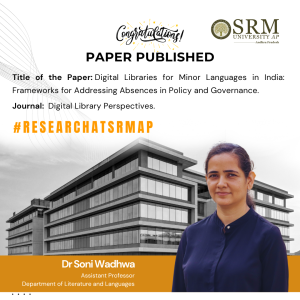 In a significant academic achievement, Dr Soni Wadhwa, Assistant Professor in the Department of Literature and Languages, has recently published a paper titled “Digital Libraries for Minor Languages in India: Frameworks for Addressing Absences in Policy and Governance.” The paper was published in the esteemed Journal Digital Library Perspectives. Dr Wadhwa’s research illuminates the importance of establishing digital libraries for minor languages in India and proposes frameworks to address existing gaps in policy and governance. This pioneering work not only explores the significance of preserving linguistic diversity but also advocates for inclusive and accessible digital resources for all.
In a significant academic achievement, Dr Soni Wadhwa, Assistant Professor in the Department of Literature and Languages, has recently published a paper titled “Digital Libraries for Minor Languages in India: Frameworks for Addressing Absences in Policy and Governance.” The paper was published in the esteemed Journal Digital Library Perspectives. Dr Wadhwa’s research illuminates the importance of establishing digital libraries for minor languages in India and proposes frameworks to address existing gaps in policy and governance. This pioneering work not only explores the significance of preserving linguistic diversity but also advocates for inclusive and accessible digital resources for all.
The publication of this paper not only adds to Dr Wadhwa’s scholarly contributions but also highlights the commitment of SRM University-AP faculty members to engaging in research that can have a positive impact on society.
Abstract
This study aims to deliberate on strategies for enlisting community support for gathering diverse learning resources in different languages and for enlisting participation in activities such as crowdsourcing in initiatives such as annotations and transliteration. This paper calls for interventions that imagine and create infrastructure for the flourishing of smaller libraries that can draw from and feed into large-scale national and international libraries. Offering a conceptual framework to rethink the country’s approach toward minor languages, it first offers an overview of policies and initiatives relevant to the concerns of minor languages in digital libraries in India. Based on the policy analysis, it then goes on to suggest starting points for policy designers and custodians of libraries to help them work toward better representation of languages in their resources.
The existing frameworks analyzed here for the greater or representation of minor Indian languages reveal a culture of silence toward the issue of language. With some advocacy, these frameworks can be mined to craft different ways that are critical not just for enriching libraries but also for preservation of cultural heritage of the communities concerned, thus adding a larger social dimension to the question of access.
Explanation of the Research in Layperson’s terms
Given that Indian languages in general are under-represented on the internet and that languages of minority linguistic groups find very little space on digital platforms, it is imperative for institutions such as libraries to cater to smaller communities and their educational needs while also reaching out to them in their own languages. While a lot of socio-political discourse on minority languages in India exists, this study pushes for their bearing on digital libraries, educational frameworks and cultural heritage. It offers five suggestions for strengthening the presence of minor languages in digital libraries in India.
Details in citation format
Wadhwa, S. (2024), “Digital libraries for minor languages in India: frameworks for addressing absences in policy and governance”, Digital Library Perspectives, Vol. ahead-of-print No. ahead-of-print. https://doi.org/10.1108/DLP-01-2024-0002
Practical Implications
This viewpoint paper can be used to enhance policy and governance around libraries. With National Education Policy 2020, which emphasises the importance of learning in regional/mother/Indian languages, Indian educational system as well as social institutions need stronger platforms to make resources in Indian languages available to students as well as lifelong learners. With more of such research, it will be possible to come up better digital infrastructure for Indian languages.
Social Implications
Indian languages are not widely represented on the Internet and in the knowledge set up. Making existing resources and knowledge available in digital libraries will stimulate further research on generating further research and knowledge production in Indian languages. It is hoped that more research in the domain of Indian languages works towards the digital divide and knowledge divide in India.
Collaborations
This research came out of the researcher’s previous archival work. Her digital archive PG Sindhi Library is dedicated to post-partition Sindhi writing in India. This article is based on an invited talk delivered at the international symposium titled “Digital Libraries: Sustainable Development in Education” held at IIT Kharagpur in India in November 2023. The author is grateful to the organisers and fellow participants for their feedback.
Future Research Plans
The researcher is involved in a sanctioned project titled “Sindhi Sanchaya: Building a Comprehensive and Interactive Database of a Partitioned Literature” funded by IIT Indore. She hopes to build on this work produced in this article as she makes progress in the project.
- Published in Departmental News, English Current Happenings, News, Research News
Groundbreaking Paper Offers Geo-Temporal Visualisation of COVID-19 Spread in India
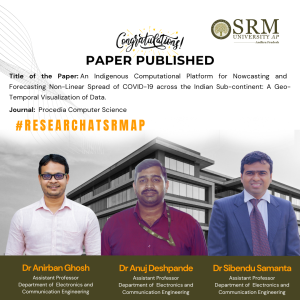 In an exciting development, Dr Anirban Ghosh, Dr Anuj Deshpande, and Dr Sibendu Samanta, Assistant Professors from the Department of Electronics and Communication Engineering, have recently achieved a significant milestone with the publication of their paper titled “An Indigenous Computational Platform for Nowcasting and Forecasting Non-Linear Spread of COVID-19 across the Indian Sub-continent: A Geo-Temporal Visualization of Data” in the esteemed journal, Procedia Computer Science.
In an exciting development, Dr Anirban Ghosh, Dr Anuj Deshpande, and Dr Sibendu Samanta, Assistant Professors from the Department of Electronics and Communication Engineering, have recently achieved a significant milestone with the publication of their paper titled “An Indigenous Computational Platform for Nowcasting and Forecasting Non-Linear Spread of COVID-19 across the Indian Sub-continent: A Geo-Temporal Visualization of Data” in the esteemed journal, Procedia Computer Science.
The paper focuses on the development of a state-of-the-art computational platform specifically tailored for nowcasting and forecasting the non-linear spread of COVID-19 across the Indian sub-continent. This pioneering work promises to offer valuable insights into the geo-temporal visualisation of data related to the COVID-19 pandemic, with potential implications for public health interventions and policy decisions.
The publication of this paper serves as a testament to the innovative research being conducted by the faculty members at the Department of Electronics and Communication Engineering. Their dedication and expertise in the field have not only contributed to advancing scientific knowledge but also hold considerable promise for making a real-world impact in the ongoing fight against the COVID-19 pandemic. We extend our congratulations to Dr Anirban Ghosh, Dr Anuj Deshpande, and Dr Sibendu Samanta for this remarkable accomplishment and look forward to witnessing the continued impact of their research in addressing critical challenges facing the world today.
Abstract
The rapid spread of the COVID-19 pandemic necessitated unprecedented collective action against coronavirus disease. In this light,we are proposing a novel online platform for the visualisation of epidemiological data incorporating social determinants for understanding the patterns associated with the spread of COVID- 19. The current AI computational platform combines modelling methodologies along with temporal, geospatial visualisation of COVID-19 data, providing real-time sharing of graphic analytical simulation of vulnerable hotspots of recurrent (nowcasting) and emergent (forecasting) infections visualised on a spatiotemporal scale on geoportals. The proposed study will be a secondary data analysis of primary data accessed from the national portal (Indian Council of Medical Research (ICMR)) incorporating 766 districts in India. Epidemiological data related to spatiotemporal visualisation of the demographic spread of COVID-19 will be displayed using a compartmental socio-epidemiological model, reproduction number R, epi-curve diagrams, as well as choropleth maps for different levels of administrative and development units at the district levels.
Explanation of the Research in Layperson’s Terms
The rapid spread of COVID-19 required quick and coordinated action. To aid the process, we have created a new online platform to help visualise COVID-19 data, including social factors that affect its spread. Our platform uses advanced computer models and shows COVID-19 data over time and across locations. It allows real-time sharing of visual analyses, highlighting areas at risk for current and future infections. The effectiveness of the platform lies in the fact that it is not limited to COVID-19. It can be suitably modified and employed for capturing similar trends for any future pandemic.
Title of the Research in the Citation Format
Priya Ranjan, Dhruva Nandi, Karuna Nidhi Kaur, Rohan Rajiv, Kumar Dron Shrivastav, Anirban Ghosh, Anuj Deshpande, Sibendu Samanta, Rajiv Janardhanan, “An Indigenous Computational Platform for Nowcasting and Forecasting Non-Linear Spread of COVID-19 across the Indian Sub-continent: A Geo-Temporal Visualization of Data”, Procedia Computer Science, Volume 235, 2024, Pages 496-505, ISSN 1877-0509,
https://doi.org/10.1016/j.procs.2024.04.049
Practical Implementation and Social Implications Associated
As mentioned earlier, the platform can be used to present real-time data analysis and identify emerging and current hotspots of the COVID-19 pandemic. However, the beauty or robustness of the platform lies in the fact that it can be suitably adapted for similar analysis for any future pandemic with minimum effort.
Collaborations
- University of Petroleum and Energy Studies, Energy Acres, Dehradun, Uttarakhand, India
- SRM Medical College Hospital and Research Centre, SRMIST, Kattankulathur, Tamil Nadu, 603203, India
- Amity Institute of Public Health, Amity University, Noida, Uttar Pradesh, 201303, India
Future Research Plans
The future plan includes improving the visual and graphical presentation of the platform to provide more insightful and intuitive information. Aggregation of data from other international databases would further augment the effectiveness of the platform by not limiting it to only the national scenario.
- Published in Departmental News, ECE NEWS, News, Research News
Dr Sanjay Kumar and Team Publish Digital Image Security Invention in the Patent Office Journal
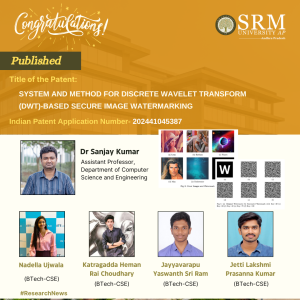 In a recent development, Dr Sanjay Kumar, Assistant Professor in the Department of Computer Science and Engineering, along with a team comprising N Ujwala, J Yashwanth Sri Ram, J Lakshmi Prasanna Kumar, and K Heman Rai Choudhary, have successfully filed and published an innovative invention in the Patent Office Journal titled “SYSTEM AND METHOD FOR DISCRETE WAVELET TRANSFORM (DWT)-BASED SECURE IMAGE WATERMARKING” with the application number “202441045387”.
In a recent development, Dr Sanjay Kumar, Assistant Professor in the Department of Computer Science and Engineering, along with a team comprising N Ujwala, J Yashwanth Sri Ram, J Lakshmi Prasanna Kumar, and K Heman Rai Choudhary, have successfully filed and published an innovative invention in the Patent Office Journal titled “SYSTEM AND METHOD FOR DISCRETE WAVELET TRANSFORM (DWT)-BASED SECURE IMAGE WATERMARKING” with the application number “202441045387”.
This invention holds great promise in the field of digital image security and watermarking. The patented system and method are based on the discrete wavelet transform (DWT), a widely used signal processing technique, to embed secure watermarks into digital images. The application of DWT ensures that the watermarking process is robust and secure, making it suitable for a wide range of applications where image integrity and authenticity need to be ensured.
Dr Sanjay Kumar’s expertise as an Assistant Professor, coupled with the team’s skills and dedication, has resulted in the successful development and patenting of this cutting-edge technology. The “SYSTEM AND METHOD FOR DISCRETE WAVELET TRANSFORM (DWT)-BASED SECURE IMAGE WATERMARKING” promises to be a significant addition to the field of digital image security and watermarking, offering enhanced protection against unauthorised tampering and misuse of digital images. It is expected that this invention will garner attention from industry professionals, researchers, and policymakers, paving the way for its integration into diverse digital imaging systems.
Abstract
Our research introduces a robust image watermarking technique that combines Discrete Wavelet Transform (DWT) and chaotic map-based encryption. The method analyzes high-frequency sub-bands derived from DWT applied to the blue channel of an RGB image, selecting the block with the highest energy for embedding a grayscale watermark encrypted with the Henon Map. The alpha blending technique is used to integrate the encrypted watermark, ensuring both imperceptibility and robustness. The method achieves an average PSNR of 43.7211 dB and SSIM of 0.9950. The watermark can be extracted by analyzing patterns in the high-frequency component, even after various attacks, using inverse DWT and Henon Map for decryption.
Explanation of the Patent in Layperson’s Terms
Our research focuses on protecting digital images by embedding a hidden watermark that is hard to remove. We use a mathematical method called the Discrete Wavelet Transform (DWT) to break down an image into different parts and find the best place to hide the watermark. The watermark is further secured by encrypting it with a technique called the Henon Map. Our method ensures that the watermark remains invisible to the naked eye while being resistant to tampering. This means the watermark can be detected and recovered even if the image is altered.
Practical Implementation and the Social Implications
The primary application of our research is in protecting the ownership and integrity of digital images. This technique can be used by photographers, artists, and digital content creators to ensure their work is not copied or altered without permission. By embedding a secure, invisible watermark, they can prove ownership and detect unauthorised use. Additionally, this method can be applied in sensitive fields such as medical imaging and legal documents where tamper detection is crucial.
Collaborations
This research was conducted by the Visual Information Processing Lab at the Department of Computer Science and Engineering, SRM University AP, Guntur, India. The team comprised Nadella Ujwala, Sanjay Kumar, Jayyavarapu Yaswanth Sri Ram, Jetti Lakshmi Prasanna Kumar, and Katragadda Heman Rai Choudhary.
Future Research Plans
Our future research will focus on enhancing the watermarking technique’s robustness against more sophisticated attacks, exploring real-time applications in video watermarking, and developing methods to embed multiple watermarks in a single image. We also aim to reduce the computational complexity to make the algorithm more efficient for practical applications.
- Published in CSE NEWS, Departmental News, News, Research News
CSE Academic Innovators File Patent for AI-Powered Refrigeration System
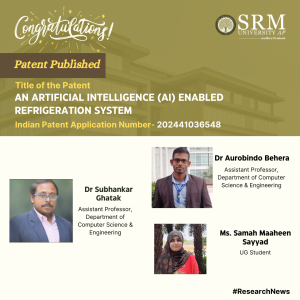 In a significant development for the field of artificial intelligence and sustainable technologies, Dr Subhankar Ghatak, Dr Aurobindo Behera, Assistant Professor, and Ms Samah Maaheen Sayyad, an undergraduate student from the Department of Computer Science and Engineering, have collectively filed a patent for an “Artificial Intelligence (AI) Enabled Refrigeration System.” The patent, bearing the Application Number 202441036548, has been officially published in the Patent Office Journal, marking a milestone in their academic and research careers.
In a significant development for the field of artificial intelligence and sustainable technologies, Dr Subhankar Ghatak, Dr Aurobindo Behera, Assistant Professor, and Ms Samah Maaheen Sayyad, an undergraduate student from the Department of Computer Science and Engineering, have collectively filed a patent for an “Artificial Intelligence (AI) Enabled Refrigeration System.” The patent, bearing the Application Number 202441036548, has been officially published in the Patent Office Journal, marking a milestone in their academic and research careers.
This innovative refrigeration system promises to enhance efficiency and reduce energy consumption, potentially revolutionising the way we preserve food and other perishables. The team’s dedication to integrating AI into practical applications is a testament to their commitment to advancing technology for the betterment of society. The academic community and industry experts alike are eagerly anticipating further details on the implementation and impact of this patented technology.
Abstract
The invention is an advanced smart and AI-enabled refrigerator that seamlessly integrates device and software components. Key features include automatic quantity detection, a reminder system, a spoiler alert system, an inbuilt voice system, an inbuilt barcode scanner, an emotion detection system, and a personalised recipe recommendation system based on user preferences, weather conditions, season, location, and precise quantity measurements.
Research in Layperson’s Terms
The invention represents a groundbreaking improvement in traditional refrigerators, providing a new and enriched user experience through AI integration. It addresses food management, user interaction, and personalised recipe recommendations, incorporating user preferences, weather considerations, seasonal variations, location-specific nuances, and accurate quantity measurements.
Practical implementation and the social implications associated with it
The practical implementation of the “AN ARTIFICIAL INTELLIGENCE (AI) ENABLED REFRIGERATION SYSTEM ” involves the seamless integration of advanced hardware and sophisticated AI algorithms to create an intelligent and user-friendly refrigerator. The following steps outline the practical implementation:
Hardware Integration:
Sensors: Install advanced sensors, including thermistors for temperature, humidity sensors, barcode scanners, ultrasonic quantity measurement sensors, cameras, spoilage identification sensors, level sensors, defrost sensors, and weight sensors within the refrigerator compartments.
Voice and Emotion Detection Modules: Incorporate a microphone and speaker system for voice interaction and integrate cameras and emotion analysis algorithms for facial recognition and emotion detection.
Connectivity Components: Equip the refrigerator with Wi-Fi or Bluetooth modules to enable seamless data transfer and communication with other smart devices.
Processor and Memory: Utilize a powerful processor and ample memory to support AI algorithms, data processing, and smooth operation.
Display Panel: Implement an LED or touchscreen display for user interaction, providing real-time information and control over the refrigerator’s functionalities.
Software Development:
AI Algorithms: Develop and integrate AI algorithms for automatic quantity detection using computer vision, sentiment analysis for emotion detection, and collaborative filtering for personalised recipe recommendations.
Natural Language Processing (NLP): Implement NLP algorithms to enable the inbuilt voice system to understand and respond to user commands effectively.
Image Recognition Software: Utilize image recognition software to accurately read barcodes and analyse visual data from the integrated cameras.
Connectivity Software: Develop software protocols to ensure reliable wireless communication between the refrigerator and other devices or cloud services.
User Interface Software: Design a user-friendly interface for the display panel, allowing users to interact with and manage refrigerator contents easily.
Social Implications:
The “AI Enabled Refrigeration System” invention has several profound social implications:
1. Reduction in Food Wastage: The automatic quantity detection, reminder system, and spoilage alert system significantly reduce food wastage by ensuring that users are alerted about unused items and potential spoilage. This contributes to more efficient food management and a reduction in household food waste, addressing a critical global issue.
2. Enhanced Food Safety and Health: By providing real-time alerts about food spoilage and precise quantity measurements, the invention ensures that users consume fresh and safe food. This minimizes health risks associated with consuming spoiled food and promotes overall well-being.
3. Personalized Dietary Support: The personalized recipe recommendation system caters to individual dietary preferences and requirements, promoting healthier eating habits. By suggesting recipes based on user preferences, weather conditions, seasonality, and location, the system encourages balanced and nutritious meal planning.
4. Convenience and Efficiency: The inbuilt voice system, emotion detection, and intuitive user interface enhance the convenience and efficiency of managing refrigerator contents. Users can easily access information, receive reminders, and interact with the refrigerator, making food storage and preparation more streamlined.
5. Technological Advancements: The integration of advanced AI technologies in everyday appliances like refrigerators represents a significant step forward in smart home innovation. This can drive further advancements in the field, encouraging the development of more intelligent and interconnected household devices.
6. Environmental Impact: By promoting efficient food management and reducing wastage, the invention indirectly contributes to environmental sustainability. Less food waste translates to lower carbon footprints and reduced strain on food production resources, aligning with global efforts to combat climate change.
Overall, the “AI Enabled Refrigeration System” invention not only offers practical benefits in terms of food management and user convenience but also holds significant social implications by promoting health, reducing waste, and advancing technological innovation in household appliances.
Future Research Plans
Building on the innovative foundation of the “AN ARTIFICIAL INTELLIGENCE (AI) ENABLED REFRIGERATION SYSTEM, ” future research plans involve enhancing the AI algorithms for even greater accuracy in food quantity detection, spoilage prediction and personalised recipe recommendations. This includes exploring more advanced machine learning techniques and incorporating real-time feedback mechanisms to continuously refine the system’s performance. Additionally, research will focus on integrating the refrigerator with broader smart home ecosystems, allowing for seamless interaction with other smart appliances and IoT devices to create a fully connected kitchen experience. Investigations into more sustainable and energy-efficient sensor technologies will also be pursued to further reduce the environmental footprint of the device. Finally, extensive user studies will be conducted to gather feedback and insights, ensuring that the next iterations of the refrigerator are even more aligned with consumer needs and preferences, ultimately driving widespread adoption and maximising the social benefits of this technology.
Pictures Related to the Research
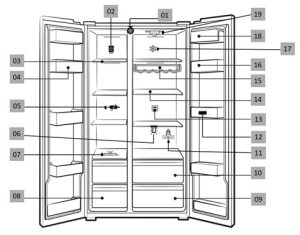
Fig 1: Schematic Arrangement of various Components for adequate operation of the proposed scheme

Fig 2: Schematic Arrangement of various Components for user interaction

Fig 3: Schematic representation of working of various components in the freezer system
• Pointer Number-27: Spoilage Detection Sensor (19) detects the item that is being spoiled and maps to particular item for alerting the user with the help of the capturing Device (01) and the info associated with that particular item like Expiry date etc.
• Pointer Number-28: The Ultra Sonic Quantity Measurement Sensor (06) senses the quantity of the ITEM “x” (24), and the camera (01) is used to identify what is ITEM “x” through (23).
• Pointer Number-29: Weight Sensor (07), using newly captured item ITEM “x” (24) by capturing device (01), identifies the weight of that item by subtracting the weight obtained after the addition of that item with the initial holding by the cabinet and attaching the value with corresponding ITEM “x” (24).
• Pointer Number-30: Barcode Scanner (12) scans the Barcode associated with the item and maps the corresponding information with that particular item with the help of the capturing device (01).
• Port Number-31: Mobile Application.
- Published in CSE NEWS, Departmental News, News, Research News
Chetna: Awakening Mathematical Minds
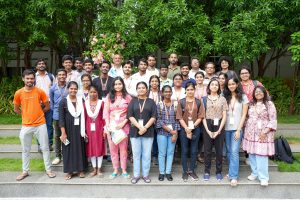 The Department of Mathematics at SRM University-AP successfully conducted a two-week summer programme “Chetna: Awakening Mathematical Minds” from June 17th to June 28th, 2024. This programme aimed to inspire and enhance mathematical understanding among participants from various parts of the country. The programme saw enthusiastic participation from 25 students hailing from different states across India, including West Bengal, Assam, Kerala, Karnataka, Tamil Nadu, Maharashtra, Gujarat, Delhi and Andhra Pradesh.
The Department of Mathematics at SRM University-AP successfully conducted a two-week summer programme “Chetna: Awakening Mathematical Minds” from June 17th to June 28th, 2024. This programme aimed to inspire and enhance mathematical understanding among participants from various parts of the country. The programme saw enthusiastic participation from 25 students hailing from different states across India, including West Bengal, Assam, Kerala, Karnataka, Tamil Nadu, Maharashtra, Gujarat, Delhi and Andhra Pradesh.
The programme featured a diverse curriculum, covering a wide range of mathematical topics. Eleven subjects were taught by eleven distinguished faculty members from the Department of Mathematics. The subjects provided a broad and enriching mathematical experience, designed to ignite a passion for mathematics in the participants.
Insights of the Two-Week Programme
First Week Highlights
1. Number Theory by Prof. Kalyan Chakraborty
The first week began with an in-depth exploration of Number Theory. Prof. Kalyan Chakraborty introduced participants to fundamental concepts such as divisibility, prime numbers, and modular arithmetic. The engaging sessions provided a strong foundation in understanding the properties and applications of numbers.
2. Abstract Algebra by Dr Anirban Bose
Dr Anirban Bose led the sessions on Abstract Algebra, diving into structures like groups, rings, and fields. The course covered essential algebraic concepts and their applications, enhancing the participants’ problem-solving skills and theoretical knowledge.
3. Linear Algebra and Basic Operators by Dr Animesh Bhandari
Dr Animesh’s lectures on Linear Algebra included topics such as vector spaces, linear transformations, and matrices. The sessions aimed to build a solid understanding of linear systems and the role of operators in mathematical computations.
4. Graph Theory by Dr Fouzul Atik
Graph Theory, taught by Dr Fouzul Atik, introduced participants to the study of graphs, which are mathematical structures used to model pairwise relations between objects. Topics included graph traversal, connectivity, and graph colouring, providing insights into the practical applications of graph theory.
5. Ordinary Differential Equation by Dr Nityananda Roy
The week concluded with Dr Nityananda Roy’s sessions on Ordinary Differential Equations (ODEs). This course covered methods of solving first-order and higher-order ODEs, along with real-world applications of differential equations in various fields.
Second Week Highlights
1. Advanced Algebra by Dr Kalyan Banerjee
Building on the first week, this subject delved deeper into algebraic structures, including advanced group theory and ring theory, preparing students for research-level problems.
2. Metric Spaces by Dr Choiti Bandyopadhyay
Dr Choiti’s sessions on Metric Spaces introduced participants to the concepts of distance and convergence in metric spaces. Topics included open and closed sets, continuity, and compactness, providing a deeper understanding of analysis.
3. Foundations of Probability and Statistics by Dr Vijayakrishna Rowthu
Dr. Vijayakrishna covered the Foundations of Probability and Statistics, focusing on probability theory, random variables, and statistical inference. The course aimed to equip participants with the skills needed to analyze and interpret data.
4. Mathematical Modelling by Dr Tapan Kumar Hota
Dr. Tapan’s lectures on Mathematical Modelling demonstrated how mathematics can be used to represent, analyse, and solve real-world problems. The course included case studies and practical applications in various disciplines.
5. Partial Differential Equation by Dr Ram Baran Verma
The sessions on Partial Differential Equations (PDEs) by Dr Ram Baran explored methods of solving PDEs and their applications in physics and engineering. Topics included separation of variables, Fourier series, and boundary value problems.
6. Math Education by Dr Jayasree Subramanian
The final course on Math Education, taught by Dr Jayasree, focused on pedagogical approaches and techniques for teaching mathematics effectively. The sessions aimed to inspire future educators and enhance their teaching methodologies.
Conclusion
The “Chetna: Awakening Mathematical Minds” summer programme was a resounding success, providing participants with valuable insights and knowledge in mathematics. The diverse backgrounds of the participants and the expertise of the faculty created a vibrant and stimulating learning environment, fostering a deeper appreciation for the subject. The Department of Mathematics at SRM University -AP looks forward to organising similar programmes in the future to continue inspiring young mathematical minds across the country.
- Published in Departmental News, Math News, News
SRM AP Signs MoU with Human Resocia to Create Employment Opportunities in Japan for Students
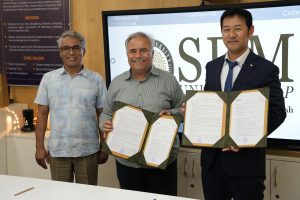 SRM University-AP has signed an MoU with Human Resocia to facilitate employment and job opportunities for university students in Japan. This collaborative agreement partners HR to provide all the necessary facilities required for students to pursue career opportunities in Japan.
SRM University-AP has signed an MoU with Human Resocia to facilitate employment and job opportunities for university students in Japan. This collaborative agreement partners HR to provide all the necessary facilities required for students to pursue career opportunities in Japan.
The MoU signing ceremony, organised yesterday, was honoured by esteemed individuals, including Prof. Manoj K Arora, Vice Chancellor of SRM University-AP, Dr M S Vivekanandan, Director of CRCS, Prof. C V Tomy, Dean SEAS, Mr Laxmanan Angu Raju, AGM of CRCS, Mr K Jotish Kumar, CEO of SRM Global, along with representatives from Human Resocia (HR) such as Mr Takeshi Tominaga, Mr Yuji Sakaguchi, Mr Taketo Fukuda, Mr Kagotani Takuya, and Mr Senthil Sellappan.
This Alliance between SRM University-AP and HR will primarily focus on recruiting students, providing Japanese language learning for recruitment in Japan as well as to identify opportunities where both entities can collaborate with Japanese universities or other relevant stakeholders of Japan be it academic or industry. With a goal to develop the employability and cross-cultural learning experience of students, this collaboration is all set for mutual growth and development.
Prof. Manoj K Arora, Vice Chancellor of SRM University-AP, expressed his enthusiasm: “This strategic partnership with Human Resocia marks a milestone in our efforts to provide international career opportunities for our students in Japan. We are very excited about the prospects that this MoU brings, and we are committed to preparing our students for successful careers ahead.”
Human Resocia Co., Ltd. is a recruiting and dispatch company in Japan that has been established for more than 30 years. It specialises in helping individuals develop their careers as IT engineers in the nation. Their rich experience in understanding the evolving needs of job seekers and how to help millions of job seekers and lakhs of recruiters like no one else does makes them a perfect ally, and we are happy that they trust us on this step.
This MoU signifies a significant step towards empowering students of SRM University-AP to begin a promising career path in Japan. It reflects the University’s commitment to providing holistic opportunities for professional growth and international exposure.
- Published in CR&CS, CR&CS NEWS, Departmental News, News


